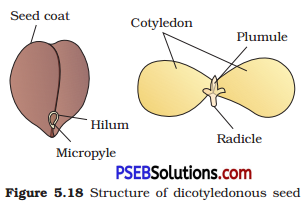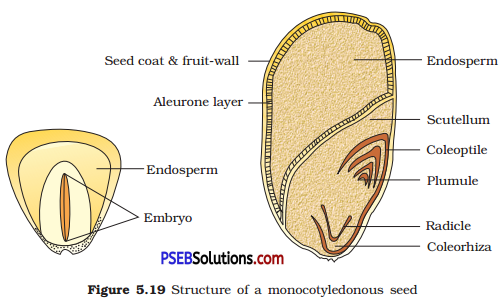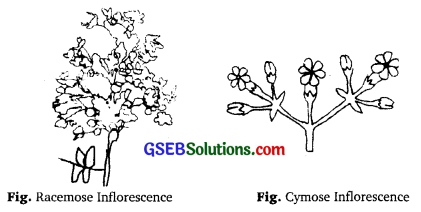Punjab State Board PSEB 11th Class Biology Book Solutions Morphology of Flowering Plants Textbook Exercise Questions and Answers.
PSEB Solutions for Class 11 Biology Morphology of Flowering Plants
PSEB 11th Class Biology Guide Morphology of Flowering Plants Textbook Questions and Answers
Question 1.
What is meant by modification of root? What type of modification of root is found in the:
(a) Banyan tree
(b) Turnip
(c) Mangrove trees
Answer:
Modification of Root: Roots in some plants change their shape and
structure and become modified to perform functions, other than absorption and conduction of water and minerals. The roots are modified for water, absorption, support, storage of food and respiration.
(a) A banyan tree have hanging roots known as prop roots.
(b) The roots of turnip get modified to become swollen and store food.
(c) The roots of mangrove trees get modified to grow vertically upwards and help to get oxygen for respiration. These are known as pneumatophores.
Question 2.
Justify the following statements on the basis of external features:
(a) Underground parts of a plant are not always roots.
(b) Flower is a modified shoot.
Answer:
(a) Underground parts of a plant are not always roots, they are subterranean stems which do not have root hairs and root cap. Have terminal bud, nodes and internodes. Have leaves on the nodes.
Most of the underground stems such as sucker, rhizome, corm, tubers, bulb, etc., store food, form aerial shoots.
(b) Flower is a modified shoot because:
- It possess nodes and internodes.
- It may develop in the axil of small leaf-like structure called bract.
- Flowers get modified into bulbils or fleshy buds in some plants.
- Anatomically the pedicel and thalamus of a flower resemble that of stem.
- The vascular supply of different organs of flower resemble that of normal leaves.
- In the flower of Degeneria, the stamens are expanded like leaves and the carpels appear like folded leaves.
Question 3.
How is a pinnately compound leaf different from a palmately compound leaf?
Answer:
In pinnately compound leaf, the number of leaflets are present on a common axis, the rachis, which represents the midrib of the leaf as in neem. In case of a palmately compound leaf, the leaflets are attached at a common point, i e., at the tip of petiole as in silk cotton.
![]()
Question 4.
Explain with suitable examples the different types of phyllotaxy.
Answer:
Phyllotaxy is the pattern of arrangement of leaves on the stem or branch. This is usually of three types—alternate, opposite and whorled.
- In alternate phyllotaxy, a single leaf arises at each node in alternate manner, as in China rose, mustard and sunflower plants.
- In opposite type of phyllotaxy, a pair of leaves arise at each node and lie opposite to each other as in Calotropis and guava plants.
- If more than two leaves arise at each node and form, a whorl, it is called as whorled, as in Alstonia.
Question 5.
Define the following terms:
(i) Aestivation
(ii) Placentation
(iii) Actinomorphic
(iv) Zygomorphic
(v) Superior ovary
(vi) Perigynous flower
(vii) Epipetalous stamen
Answer:
(i) Aestivation: The mode of arrangement of sepals or petals in relation to one another in a flower bud is called aestivation.
(ii) Placentation: The pattern by which the ovules are attached in an ovary is called placentation.
(iii) Actinomorphic: A flower having radial symmetry. The parts of each whorl are similar in size and shape. The flower can be divided in two equal halves along more than one median longitudinal plane.
(iv) Zygomorphic: A flower having bilateral symmetry. The parts of one or more whorls are dissimilar. The flower can be divided into two equal halves in only one vertical plane.
(v) Superior ovary: The ovary is called superior when it is borne above the point attachment of perianth and stamens on the thalamus.
(vi) Perigynous flower: It is the condition in which gynoecium of a flower is situated in the centre and other parts of the flower are located on the rim of the thalamus almost at the same level.
(vii) Epipetalous stamen: Stamens adhere to the petals by their filaments so, appear to arise from them.
![]()
Question 6.
Differentiate between:
(a) Racemose and cymose inflorescence
(b) Fibrous root and adventitious root
(c) Apocarpous and syncarpous ovary
Answer:
(a) Differences between Racemose and Cymose Inflorescence.
| Racemose | Cymose |
| 1. This is further divided into (a) Raceme (b) Catkin (c) Spike (d) Spadix (e) Corymb (f) Umbel or capitutum | It is further divided into (a) Monochasial cyme (b) Dichasial Cyme (c) Polychasial Cyme. |
| 2. Branches develop indefinitely and further branches arise laterally in acropetal manner. | The branches arise from terminal buds and stop growing after some time Lateral branches grow much vigorously and spread like a dome. |
(b) Differences between Fibrous Root and Adventitious Root
| Fibrous Root | Adventitious Root |
| In monocotyledonous plants, the primary root is short lived and is replaced by a latge number of roots. These roots originate from the base of the fibrous root system say, for example in wheat plants. | In some plants, say for example, in grass and banyan tree there are roots arising from parts of the plant other than the radicle. These are called adventitious roots. |
(c) Differences between Apocarpous Ovaiy and Syncarpous Ovary
| Apocarpous Ovary | Syncarpous Ovary |
| When more than one carpel is present, they may be free (as in lotus and rose) and are called apocarpous ovary. | They are termed syncarpous ovary when fused, as in mustard and tomato. After fertilisation, the ovules develop into seeds and like ovary matures into a fruit. |
![]()
Question 7.
Draw the labelled diagram of the following:
(a) gram seed
(b) V.S. of maize seed
Answer:
(a) Gram Seed

(b) V.S. of maize seed

Question 8.
Describe modifications of stem with suitable examples. [NCERT]
Answer:
Modifications of stem are as follows:
- Tendrils help plants to climb on the support, e. g., Cucumber.
- Thorns are woody, pointed, straight structures to protect plants from browsing animals, e. g., Bougainvillea.
- The plants in arid regions modify their stems into flattened (Opuntia) or fleshy cylindrical (Euphorbia) structures. They contain chlorophyll and carry out photosynthesis.
- Underground stems of some plants such as grass and snawberry, etc., spread to new riches and when older parts die, new plants are formed.
- In Pistia and Eichhornia, a lateral branch with short internodes and each node bearing a rosette of leaves and a tuft of roots is found.
- Stolons or runners help in vegetative propagation in jasmine and grass, respectively.
![]()
Question 9.
Take one flower each of the families Fabaceae and Solanaceae and write its semi-technical description. Also draw their floral diagram after studying them.
Answer:
(i) Fabaceae: This family was earlier called Papilionoideae, a subfamily of family Leguminosae.
(a) Habit: Trees, shrubs, herbs, climbers, etc.
(b) Root System: Tap root system with root nodules, that harbour nitrogen fixing bacterium.
(c) Leaves: Leaves are alternate, simple or pinnately compound, pulvinate, and stipulate; venation reticulate.
(d) Inflorescence: Racemose usually, a raceme.
(e) Flowers: Bracteate, bracteolate, bisexual, zygomorphic, hypogynous, and pentamerous.
(f) Calyx: Five sepals, gamosepalous, irregular, odd sepal anterior (characteristic feature of the family) and valvate aestivation.

(g) Corolla: Corolla consists of five petals, polypetalous, characteristically papilionaceous, with an odd posterior large petal called standard or vexillum, a pair of lateral petals, called wing or alae and two anterior keel or carina, which enclose the essential organs; aestivation is vexillary.
(h) Androecium: Ten stamens, diadelphous, [(9) + 1] and anthers dithecous.
(i) Gynoecium: Ovary is superior, monocarpellary, unilocular with many ovules on marginal placenta; style single, curved or bent at right angles to the ovary.
(j) Fruits and Seeds: Characteristically a legume/pod and seeds are non-endospermic.
(k) Floral Formula: ![]()
(l) Economic Importance: Plants of this family yield pulses, edible oil, dye, fodder, fibres and wood; some yield products of medicinal value,
(ii) Solanaceae (Potato family)
(a) Habit: Plants are mostly herbs or shrubs or small trees; stem is erect, cylindrical, branched (cymose type); stem is underground in potato CSolarium tuberosum).
(b) Leaves: Simple, alternate, exstipulate with reticulate venation.
(c) Inflorescence: Axillary or extra-axillary cymose, or solitary.
(d) Flowers: Bisexual, actinomorphic, hypogynous and pentamerous.
(e) Calyx: Five sepals, gamosepalous, persistant and valvate aestivation.
(f) Corolla: Five petals, gamopetalous, valvate or imbricate, rotate/wheel-shaped.
(g) Androecium: Five stamens, epipetalous and alternating with the petals.
(h) Gynoecium: Bicarpellary, syncarpous, superior with many ovules on swollen axile placenta; carpels are obliquely placed.
(i) Fruits and Seeds: A berry (tomato and brinjal) or a capsule; seeds are endospermic.
(j) Floral Formula : ![]()
(k) Economic Importance: Many plants are used as source of food (vegetables), spice, medicines of fumigatory; some are ornamental plants.

Question 10.
Describe the various types of placentations found in flowering plants.
Answer:
Types of Placentations: The arrangement of ovules within the ovary is known as placentation. The placentations are of different types – marginal, axile, parietal, free central and basal.
Marginal placentation: In this placentation, the placenta forms a ridge along the ventral suture of the ovary and the ovules are borne on this ridge forming two rows as in pea.
Axile placentation: In this placentation, the placenta is axile and the ovules are attached to it in a multilocular ovary as in China rose, tomato, etc.
Parietal placentation: In this placentation, the ovules develop on the inner wall of the ovary or on peripheral part. Ovary is one chambered but it becomes two chambered due to the formation of a false septum known as replam, e.g., mustard.
Free central placentation: In this type of placentation, the ovules are present on the central axis of ovary and septa are absent as in Dianthus and primrose.
Basal placentation: In this placentation the placenta develops at the base of ovary and a single ovule is attached to it, as in sunflower.
![]()
Question 11.
What is a flower? Describe the parts of a typical angiospermic flower.
Answer:
Flower: It is a condensed modified reproductive shoot found in angiosperms. It often develops in the axile of a small leaf-like structure called bract. The stalk of the flower is called pedicel. The tip of the pedicel or the base of flower has a broad highly condensed multinodal region called thalamus.
A flower has following four floral structures:
- Calyx: It is made up of sepals. These are green in colour and help in photosynthesis.
- Corolla: It is the brightly coloured part containing petals.
- Androecium: It is the male reproductive part which consists of stamens. A stamen has a long filament and terminal anther. The anther produces the pollen grains.
- Gynoecium: It is the female reproductive part which consists of
carpels. A carpel has three parts, i.e., style, stigma and ovary. The ovary bears the ovules.
Question 12.
How do the various leaf modifications help plants?
Answer:
Leaf Modifications in Plants
(i) In some plants, the leaf and leaf parts get modified to form green, long, thin unbranched and sensitive thread-like structures called tendrils. The tendrils coil around the plant and provide support to the plant in climbing. Tendrils are present in pea, garden Nasturtium, Clematis, Smilax, etc.
(ii) In some plants, the leaves get modified to form curved stiff claw like hooks to help the plant in clinging to the support. Leaflet hooks are present in Bignonia.
(iii) In case of Acacia and Zizyphus, the leaves get modified to form vasculated, hard, stiff and pointed structures.
(iv) In case of Acacia longifolia, the expanded petiole gets modified and perform the function of photosynthesis in absence of lamina.
(v) In plants such as Nepenthes, the lamina is modified to form large pitcher. It is used for storing water and for digesting insect protein.
(vi) In case of Utricularia, the leaf segments are modified into small bladders, to trap small animals.
Question 13.
Define the term inflorescence. Explain the basis for the different types of inflorescence in flowering plants.
Answer:
The arrangement of flowers on the floral axis is termed as inflorescence. Depending on whether the apex gets converted into a flower or continues to grow, two major types of inflorescences are defined – racemose and cymose. In racemose type of inflorescence the main axis continues to grow, the flowers are borne laterally in an acropetal succession.
In cymose type of inflorescence the main axis terminates in a flower, hence is limited in growth. The flowers are borne in a basipetal order, as depicted in figure.

![]()
Question 14.
Write the floral formula of a actinomorphic, bisexual, hypogynous flower with five united sepals, five free petals, five f free stamens and two united carpels with superior ovary and axile placentation.
Answer:
Floral formula ![]()
Question 15.
Describe the arrangement of floral members in relation to their ‘ insertion on thalamus.
Answer:
A flower is a condensed specialised reproductive shoot found in angiosperms. The stalk of the flower is known as pedicel. The tip of the pedicel or the base of the flower has a broad highly condensed multinodal region called thalamus. The floral parts of a flower are present on the thalamus. Starting from below they are green sepals or calyx, coloured petals or corolla, stamens or androecium and carpels or gynoecium.